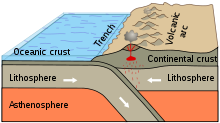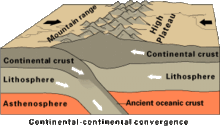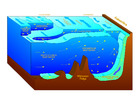- Convergent boundary
-
In plate tectonics, a convergent boundary, also known as a destructive plate boundary (because of subduction), is an actively deforming region where two (or more) tectonic plates or fragments of lithosphere move toward one another and collide. As a result of pressure, friction, and plate material melting in the mantle, earthquakes and volcanoes are common near convergent boundaries. When two plates move towards one another, they form either a subduction zone or a continental collision. This depends on the nature of the plates involved. In a subduction zone, the subducting plate, which is normally a plate with oceanic crust, moves beneath the other plate, which can be made of either oceanic or continental crust. During collisions between two continental plates, large mountain ranges, such as the Himalayas are formed.
Contents
Description
The nature of a convergent boundary depends on the type of lithosphere in the plates that are colliding. Where a dense oceanic plate collides with a less-dense continental plate, the oceanic plate is typically thrust underneath because of the greater buoyancy of the continental lithosphere, forming a subduction zone. At the surface, the topographic expression is commonly an oceanic trench on the ocean side and a mountain range on the continental side. An example of a continental-oceanic subduction zone is the area along the western coast of South America where the oceanic Nazca Plate is being subducted beneath the continental South American Plate.
Surface volcanism (volcanoes at the ocean floor or the Earth's surface) typically appears above the melts which form directly above downgoing plates. There is still debate in the geologic community as to why this is. However, the general consensus from ongoing research suggests that the release of volatiles is the primary contributor. As the subducting plate descends, its temperature rises driving off volatiles (most importantly water) encased in the porous oceanic crust. As this water rises into the mantle of the overriding plate, it lowers the melting temperature of surrounding mantle, producing melts (magma) with large amounts of dissolved gases. These melts rise to the surface and are the source of some of the most explosive volcanism on Earth because of their high volumes of extremely pressurized gases (consider Mount St. Helens). The melts rise to the surface and cool, forming long chains of volcanoes inland from the continental shelf and parallel to it.[citation needed] The continental spine of western South America is dense with this type of volcanic mountain building from the subduction of the Nazca Plate. In North America the Cascade mountain range, extending north from California's Sierra Nevada, is also of this tectonic type. Such volcanoes are characterized by alternating periods of quiet and episodic eruptions that start with explosive gas expulsion with fine particles of glassy volcanic ash and spongy cinders, followed by a rebuilding phase with hot magma. The entire Pacific Ocean boundary is surrounded by long stretches of volcanoes and is known collectively as the Pacific Ring of Fire.
Where two continental plates collide the plates either buckle and compress or (in some cases) one plate delves called subduction, under the other. Either action will create extensive mountain ranges. The most dramatic effect seen is where the northern margin of the Indian Plate is being thrust under a portion of the Eurasian Plate, lifting it and creating the Himalayas and the Tibetan Plateau beyond. It may have also pushed nearby parts of the Asian continent aside to the east.[1]
When two plates with oceanic crust converge, they typically create an island arc as one plate is subducted below the other. The arc is formed from volcanoes which erupt through the overriding plate as the descending plate melts below it. The arc shape occurs because of the spherical surface of the earth (nick the peel of an orange with a knife and note the arc formed by the straight-edge of the knife). A deep oceanic trench is located in front of such arcs where the descending slab dips downward, such as the Mariana trench near the Mariana Islands. Other good examples of this type of plate convergence would be Japan and the Aleutian Islands in Alaska.
Plates may collide at an oblique angle rather than head-on to each other (e.g. one plate moving north, the other moving south-east), and this may cause strike-slip faulting along the collision zone, in addition to subduction or compression.
Not all plate boundaries are easily defined. Some are broad belts whose movements are unclear to scientists. One example would be the Mediterranean-Alpine boundary, which involves two major plates (African and Eurasian) and several micro plates. The boundaries of the plates do not necessarily coincide with those of the continents. For instance, the North American Plate covers not only North America, but also far northeastern Siberia, plus a substantial portion of the Atlantic Ocean.
Convergent margins
A subduction zone is formed at a convergent plate boundary when one or both of the tectonic plates is composed of oceanic crust. The denser plate, made of oceanic crust, is subducted underneath the less dense plate, which can be either continental or oceanic crust. When both of the plates are made of oceanic crust, convergence is associated with island arcs such as the Solomon Islands.
An oceanic trench is found where the denser plate is subducted underneath the other plate. There is water in the rocks of the oceanic plate (because they are underwater), and as this plate moves further down into the subduction zone, much of the water contained in the plate is squeezed out when the plate begins to subduct. However, the recrystallization of ocean floor rocks, such as Serpentine, which are unstable in the upper mantle, recrystallize into Olivine, causing dehydration through loss of hydroxyl groups. This addition of water to the mantle causes partial melting of the mantle, generating magma, which then rises, and which normally results in volcanoes. This normally happens at a certain depth, about 70 to 80 miles below the Earth's surface, and so volcanoes are formed fairly close to, but not right next to, the trench.
Some convergent margins have zones of active seafloor spreading behind the island arc, known as back-arc basins.
When one plate is composed of oceanic lithosphere and the other is composed of continental lithosphere, the denser oceanic plate is subducted, often forming an orogenic belt and associated mountain range. This type of convergent boundary is similar to the Andes or the Cascade Range in North America.
When two plates containing continental crust collide, both are too light to subduct. In this case, a continent-continent collision occurs, creating especially large mountain ranges. The most spectacular example of this is the Himalayas.
When the subducting plate approaches the trench obliquely, the convergent plate boundary includes a major component of strike-slip faulting within the over-riding plate. The best example of this is the Sumatra convergent margin, where orthogonal convergence on the Sunda megathrust is occurring intermixed with movement on the Great Sumatran fault.
Examples
- the collision between the Eurasian Plate and the Indian Plate that is forming the Himalayas.
- subduction of the northern part of the Pacific Plate and the NW North American Plate that is forming the Aleutian Islands.
- subduction of the Nazca Plate beneath the South American Plate to form the Andes.
- subduction of the Pacific Plate beneath the Australian Plate, and vice versa forming the complex New Zealand to New Guinea subduction/transform boundaries.
- collision of the Eurasian Plate and the African Plate formed the Pontic Mountains in Turkey.
- Mariana Trench
- subduction of the Juan de Fuca Plate beneath the North American Plate.
Other types of plate boundaries
See also
Notes
- ^ Butler, Rob (October 2001). Where and how do the continents deform?, Himalayan tectonics, Dynamic Earth. School of Earth Sciences, University of Leeds. Accessed 2008-01-29.
External links
Categories:
Wikimedia Foundation. 2010.





